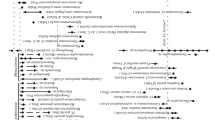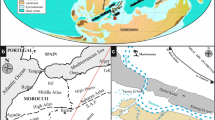Summary
The Argyrotopos profile of the Oligocene Ayii Pantes Formation in the NW Greece was studied using litho- and biofacies-analysis. The exposed sequence is mainly composed of monotonous marls and sandy marls. A rich fossil content, e.g. calcareous nannoplankton, is recorded. Some sandstone beds and two graded limestone beds with abundant lepidocyclinids and globigerinids are intercalated. The nannofossil assemblages from the measured profile of the Ayii Pantes Formation are attributed to theSphenolithus distentus Zone (NP 24) which is equivalent to theCyclicargolithus floridanus Subzone (CP 19a) of the Chattian, Upper Oligocene. The deposition took place in an euphotic subtidal environment situated on the eastern margin of the Apulian Platform. The lepidocyclinids were derived from this platform and were transported basinwards. The formation of the marls is influenced by sediment flux from the west.
Similar content being viewed by others
References
Adams, C.G. (1984): Neogene larger foraminifera, evolutionary and geological events in the context of datum planes.—In:Ikebe, N. & Tsuchi, R. (eds.): Pacific Neogene datum planes. —47–67, Tokio
Adams, C.G. (1987): On the classification of the Lepidocyclinidae (Foraminiferida) with redescriptions of the unrelated Paleogene generaActinosiphon andOrbitosiphon.—Micropaleontology33, 289–317, 4 Pls., 7 Figs., 1 Table, New York
Alexander, J., Nichols, G.J. &Leigh, S. (1990): The origins of marine conglomerates in the Pindus foreland basin, Greece.— Sedimentary Geology66, 243–254, 11 Figs., Amsterdam
Aubouin, J. (1959): Contribution a l’étude géologique de la Grèce septentrionale: le confins de l’Epire et de la Thessalie.—Ann. Géol. Pays héllen.10, 1–484, 40 Pls., 127 Figs., 6 Figs. out of text, 7 Tables, 1 Geol. Map, Athen
Baldi-Beke, M. (1984): The nannoplankton of the Transdanubian Palaeogene Formations.—Geologica Hungarica (Series Palaeontologica)43, 1–307, 42 Pls., 49 Figs., 17 Tables, Budapest
Baumann, P. von &Roth, P.H. (1969): Zonierung des Obereozäns und Oligozäns des Monte Cagnero (Zentralapennin) mit planktonischen Foraminiferen und Nannoplankton.—Eclog. geol. Helv.62, 303–323, 2 Figs., Basel
Berggren, W.A., Kent, D.V., Flynn, J.J. &Van Couvering, J.A. (1985): Cenozoic geochronology.—Bull. Geol. Soc. Am.96, 1407–1418, New York
Betzler, C. & Chaproniere, G.C.H. (1993): Paleogene and Neogene Larger Foraminifers from the Queensland Plateau: Biostratigraphy and Environmental significance.—In:McKenzie, J.A., Davies, P.J., Palmer-Julson, A., et al.,—Proc. ODP, Sci. Results133: 51–66, 5 Pls., 4 Figs., 4 Tables, College Station, Texas
Bizon, G. (1967): Contribution a la connaissance des foraminifères planctoniques d’Epire et des eles ioniennes (Grèce occidentale) depuis de Paléogène supérieur jusque’au Pliocène.—Publ. Inst. Francais Pétrole, 142 p., 37 Pls., 22 Figs., Paris
Bizon, G. &Müller, C. (1979): Remarks on the Oligocene/Miocene boundary based on results obtained from the Pacific and the Indian Oceans.—Ann. géol. Pays héllen., tome hors série, 1979/1, 101–111 2 Figs., Athen
Blow, W.H. (1969): Late Eocene to Recent planktonic foraminiferal biostratigraphy. In:Bronnimann, R. & Renz, H.H. (eds.): Proc. First Int. Conf. Plankt. Microfossils1, 199–421, 54 Pls., 43 Figs., Rome
Bolli, H.M. & Saunders, J.B. (1985): Oligocene to Holocene low latitude planktic foraminifera.—In:Bolli, H.M., Saunders, J.B. & Perch-Nielsen, K. (eds.): Plankton Stratigraphy.— 155–262, 46 Figs., Cambridge
Bosselini, F.R. &Russo, A. (1992): Stratigraphy and facies of an Oligocene fringing reef (Castro Limestone, Salento Peninsula, Southern Italy).—Facies26, 145–166, 8 Pls., 6 Figs., Erlangen
Bosselini, F.R., Russo, A., Arush, M.A. &Cabdulquadir, M.M. (1987): The Oligo-Miocene of Eil (NE Somalia): a prograding coral-Lepidocyclina system.—J. African Earth Sci.,6, 583–593, Oxford
British Petroleum Corporation (1971): The geological results of petroleum exploration in western Greece.—Inst. Geol. Subsurf. Research10, 73 p., 6 Pls., 10 Figs., Athens
Bramlette, M.N. &Wilcoxon, J.A. (1967): Middle Tertiary calcareous nannoplankton of the Cipero section, Trinidad, W.I.—Tulane Stud. Geol.5, 93–131, 10 Pls., New Orleans
Bukry, D. (1973): Low-Latitude Coccolith Biostratigraphic Zonation. —Initial Reports of the Deep Sea Drilling Project15, 685–703, 4 Pls., 5 Figs., 4 Tables, Washington
— (1975): Coccolith and Silicoflagellate stratigraphy, North-western Pacific Ocean, Deep Sea Drilling Project, Leg. 32.— Initial Reports of the Deep Sea Drilling Project32, 677–701, 2 Figs., 1 Table, Washington
Butterlin, J. (1987): Origin and evolution of the Lepidocyclines from the Caribbean region. Comparisons and relations with the Lepidocyclines from the other regions of the world.— Revue de Micropaléontologie29, 203–219, 2 Pls., 7 Figs., Paris
— (1990): Problémes posées par la systématique de la famille Lepidocyclinidae (Foraminiferida).—Revista Espanola de MicropaleontologicaXXII, 101–126 5 Pls., 7 Figs., Madrid
— (1991): Observations about the origin and evolution of the Lepidocyclinids from the Mediterranean basin.—Revue de Micropaléontologie34, 175–183, 6 Figs., Paris
Buxton, M.W.N. &Pedley, H.M. (1989): Short paper: A standarized model for Tethyan carbonate ramps.—J. Geol. Soc. London146, 746–748, 3 Figs., Northern Ireland
Chaproniere, G.C.H. (1975): Paleoecology of Oligo-Miocene larger foraminifera, Australia.—Alcheringa1, 37–58, 3 Figs., Sydney
Chaproniere, G.C.H. & Betzler, C. (1992): Larger foraminiferal biostratigraphy of sites 815, 816 and 826, LEG 133, Northeastern Australia.—In:McKenzie, J.A., Davies, P.J., Palmer-Julson, A. et al.—proc. ODP, Sci. Results133, 39–49, 1 Pls., 2 Figs., 5 Tables, College Station, Texas.
Clews, J.E. (1989): Structural control on basin evolution: Neogene to Quaternary of the Ionian zone, Western Greece.—J. Geol. Soc. London146, 447–457, 9 Figs, Northern Ireland
Drooger, C.W. &Rohling, E.J. (1988): Lepidocyclina migration across the Atlantic. Proc. Kon. Ned. Ak. Wet.B 91, 39–52, 3 Figs., Utrecht
Firth, J.V. (1992): Analysis of the taxonomic, biostratigraphic and evolutionary relationships of species of the calcareous nannofossil genusCyclicargolithus (Bukry, 1971) from the Upper Eocene and Oligocene of the North Atlantic. In:Decima, F.P., Monechi, S. & Rio, D. (eds.): Proc. of the International Nannoplankton Association Conference, Firenze 1989 Memorie di Scienze GeologicheXLIII, 237–259, 1 Pl., 11 Figs., 9 Tables, Padova
Firth, J.V. &Isiminger-Kelso, M. (1992): Pleistocene and Oligocene-Miocene calcareous nannofossils from the Simisu Rift and Izu-Bonin Forearc Basin.—Proc. ODP, Sci. Results126, 237–262, 4 Pls., 8 Figs., 11 Tables, College Station, Texas.
Fleury, J.-J. (1980): Les zones de Gavrovo-Tripolitza et du Pinde-Olonos (Grèce coninentale et Péloponnése du Nord). Evolution d’une plate-forme et d’un bassin dans leur cadre alpin.—Soc. Géol. Nord4, 1–648, 10 Pls., 29 Figs., Villeneuve d’Ascq
Frost, S.H., Harbour, J.L., Beach, D.K., Realini, M.J. &Harris, P.M. (1983): Oligocene reef tract development, southwestern Puerto Rico.—SedimentaIX, 1–107, 42 Figs., Miami
Gibson, T.G. &Margerum, R. (1991): Larger foraminifera biostratigraphy of PEACE boreholes, Enewetak Atoll, Republic of the Marshall Islands.—U.S. Geological Survey Professional Paper1513-D, 1–14, 8 Figs., Washington
Haq, B.U. (1981): Search for marker events.—In:Cati, F. (ed.),Steininger, F.F., Borsetti, A.M. & Gelati, R. (co-eds): In search of the Palaeogene/Neogene boundary stratotype. Part I: Potential boundary stratotype sections in Italy and Greece and a comparison with results from the deep-sea. International Union of Geological Sciences, Commission on Stratigraphy,3, 27–31, 1 Fig., Bologna
Haynes, J.R. (1981): Foraminifera.—433 p., 10 Pls., 95 Figs., Hong Kong (MacMillan)
Institut de Géologie et Recherches du Sous-Sol.-Athènes & Institut Francais du Pétrole-Mission Grèce (1966): Etude géologique de l’Epire (Grèce nord-occidentale).—306 p., 101 Figs., Paris
Jacobshagen, V. (1986): Geologie von Griechenland.—363 p., 111 Figs., Berlin-Stuttgart
Jones, B. &Hunter, G. (1994): Evolution of an Isolated Carbonate Bank during Oligocene, Miocene and Pliocene Times, Cayman Brac, British West Indies.—Facies30, 25–50, 4 Pls., 15 Figs., Erlangen
Kico, V. (1985): Les nannofossiles calcaires du flysch de la Zone Ionienne d’Albanie.—Thesis, Memoires des Sciences de la Terre-Paris VI, 178 p., 15 Pls., 21 Figs., Paris
Kissel, C., Lai, C. &Müller, C. (1985): Tertiary geodynamical evolution of northwestern Greece: paleomagnetic results.— Earth Planet. Science Letters72, 190–204, 10 Figs., 2 Tables, Amsterdam
Köthe, A. (1986): Kalkiges Nannoplankton aus dem Paläogen Nordwestdeutschlands. Geol. Jb.A89, 3–114, 16 Pls., 12 Figs., 7 Tables, Hannover
Clange, H. (1968): Die Evolution vonNephrolepidina undEulepidina im Oligozän und Miozän der Insel Ithaka (Westgriechenland).— Thesis. Ludwig-Maximilians-Universität München, 78 p., 3 Pls., 18 Figs., 2 Tables, München
Martini, E. (1971): Standard Tertiary and Quaternary calcareous nannoplankton Zonation.—In:Farinacci, A. (ed.): Proceedings of the Second International Conference on Planktonic Microfossils, Roma,2, 739–785, 4 Pls., 6 Tables, Rome
Martini, E. &Müller, C. (1986): Current Tertiary and Quaternary calcareous nannoplankton stratigraphy and correlations. —Newsl. Stratigr.16, 99–112, 7 Tables, Stuttgart
Meulenkamp, J.E. &Hilgen, F.J. (1986): Event stratigraphy, basin evolution and tectonics of the Hellenic and Calabro-Sicilian arcs.—In:Wezel, F.-C. (ed.): The origin of arcs.— Developments in Geotectonics,21, 327–350, 9 Figs., Amsterdam (Elsevier)
Mulder, E.F.J. de (1975): Microfauna and sedimentary-tectonic history of the Oligo-Miocenes of the Ionian islands and western Epirus (Greece).—Utrecht Micropal. Bull.13, 1–139, 4 Pls., 46 Figs., Utrecht
Okada, H. &Bukry, D. (1980): Supplementary modification and introduction of code numbers of the low-latitude coccolith biostratigraphic zonation (Bukry, 1973; 1975).—Mar. Micropaleontol.5, 321–325, 2 Tables, Amsterdam
Olafsson, G. (1992): Oligocene/Miocene morphometric variability of theCyclicargolithus Groups from the Equatorial Atlantic and India Oceans.—In:Decima, F.P., Monechi, S. & Rio, D. (eds.): Proc. of the Intern. Nannoplankton Ass. Conf., Firenze 1989. Mem. di Scienze Geol.43, 283–295, 8 Figs., 3 Tables, Padova
Perch-Nielsen, K. (1985): Cenozoic calcareous nannofossils. In:Bolli, H.M., Saunders, J.B. & Perch-Nielsen, K. (eds.): Plankton Stratigraphy, 427–553, 91 Figs., Cambridge
Perrier, R. &Koukouzas, C. (1969): Geological sheet Parga, 1∶50.000.—Institute for Geology and Subsurface Research (I.G.S.R.), Athens
Pujos, A. (1987): Late Eocene to Pleistocene medium-sized and small-sized “Reticulofenesrids”.—In:Stradner, H., Perch-Nielsen, K. (eds.): Proc. of the Intern. Nannoplankton Ass., Vienna Meeting 1985.—Abh. Geol. B.-A.39A, 239–277, 3 Pls., 29 Figs., Wien
Richter, D. (1974): Die Flyschzonen Griechenlands II. Zur Stratigraphie der basalen Schichten (Übergangsserie) des ionischen Flysches im Epiros und südlich anschließenden Gebiet.—N. Jb. Geol. Paläont. Mh.1974, 149–174, 7 Figs., Stuttgart
— (1976a): Das Flysch-Stadium der Helleniden-ein Überblick. —Z. dt. geol. Ges.127, 467–483, 1 Pls., 2 Figs., Hannover
— (1976b,c): Die Flyschzonen Griechenlands III. Flysch sowie spät- und postorogene Serien in Westgriechenland zwischen Albanien und dem Golf von Patras. Teile 1 und 2.—N. Jb. Geol. Paläont. Abh.151, 73–100, 10 Figs., und 224–252, 8 Figs., Stuttgart
— (1981): Die gefaltete marine Molasses im Gebiet von Peratia-Plagia (Akarnanien, Griechenland). Mit einem Ausblick auf die marine Molasse bei Agia Kyriaki (Epiros).—N. Jb. Geol. Paläont. Mh.1981, 84–90, 2 Figs., Stuttgart
Richter, D., Müller, C. &Mihm, A. (1993): Die Flysch-Zonen Griechenlands V. Zur Stratigraphie des Flysches der Pindos-Zone im nördlichen Pindos-Gebirge zwischen der albanischen Grenze und der Querzone von Kastaniotikos (Griechenland). —N. Jb. Geol Paläont. Mh.1993, 257–291, 8 Figs., 1 Table, Stuttgart
Roth, P.H. (1970): Oligocene calcareous nannoplankton Biostratigraphy.—Ecolg geol. Helv.63, 799–881, 14 Pls., 17 Figs., Basel
Speranza, F., Kissel, C., Islami, I., Hyseni, A. &Laj, C. (1992): First paleomagnetic evidence for rotation of the Ionian zone of Albania.—Geophys. Res. Letters19, 697–700, 4 Figs., 1 Table, Washington D.C.
Walker, K.R., Shanmugam, G., Ruppel, S.C. (1983): A model for carbonate to terrigenous clastic sequences.—Geol. Soc. Am. Bull.94, 700–712, 10 Figs., Tulsa
— (1984): Reply. A model for carbonate to terrigenous clastic sequences.—Geol. Soc. Am. Bull.95, 753, Tulsa
Wei, W. &Wise Jr., S.W. (1989): Paleogene calcareous nannofossil magnetobiochronology: Results from South Atlantic DSDP Site 516.—Mar. Micropaleontol.14, 119–152, 4 Pls., 2 Tables, Amsterdam
Zappaterra, E. (1994): Source-Rock Distribution Model of the Periadriatic Region.—Amer. Ass. Petrol. Geol. Bull.78, 333–354, 11 Figs., Tulsa
Zuffa, G.G. (1984): Discussion. A model for carbonate to terrigenous clastic sequences.—Geol. Soc. Am. Bull.95, 753, Tulsa
Author information
Authors and Affiliations
Rights and permissions
About this article
Cite this article
Bellas, S.M., Mertmann, D., Manutsoglu, E. et al. The Oligocene Argyrotopos profile in the external lonian basin (Epirus, Greece): Microfacies and microfossils. Facies 33, 107–119 (1995). https://doi.org/10.1007/BF02537446
Received:
Revised:
Issue Date:
DOI: https://doi.org/10.1007/BF02537446




